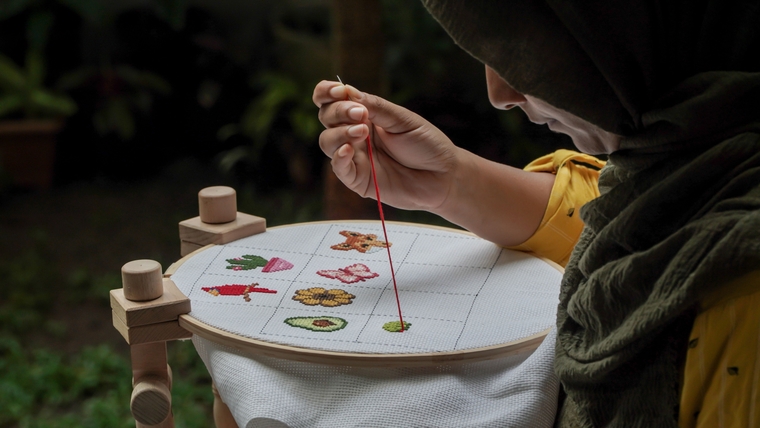Posted By: MMHA
5th May 2023
3 minute read

In celebration of Friday’s theme for Maternal Mental Health Awareness Week 2023, it’s time to focus on hope, recovery, and self-care.
As someone who personally experienced postnatal depression after the birth of my daughter, I’ve been prompted to reflect on what helped me through those dark days. While there was a myriad of things that helped, such as family support, talking therapy, medication, and time, it was engaging in creative practices, particularly stitching, that made a profound impact on my recovery and continued wellbeing.
I’m not alone in this. Using creative practices to support mental health and wellbeing is not a new concept. From soldiers being introduced to stitching to help ease PTSD symptoms, the history of women journaling, the emergence of art on prescription, and growing community participatory arts programs, the history of creative health practice is rich and diverse.
Growing research has shown that arts, crafts, creative writing, music, and dance can be incredibly beneficial in supporting mental health. Engaging in a creative activity can act as a tool for relaxation or meditative action and allow for the expression and processing of complex emotions. It can aid the individual, as well as offer opportunities to foster a sense of community and connection with others.
With that in mind, I reached out to MMHA’s network of Lived Experience Champions to find out what creative practices aided their recovery and ongoing wellbeing journey. Elaine said, “Knitting is my thing. When I was an inpatient during recovery from puerperal psychosis [postpartum psychosis], I remember teaching another patient to make doll clothes for her daughter. It helped me to help someone.”
Throughout my recovery, I was drawn to the tactile nature of working with thread and textiles.
Unable to focus on anything complex, I started simply making marks with thread on fabric. There was no agenda, no planned outcome.
After some time, this evolved into completing samplers. I used kits that came with instructions. My own capacity to create from scratch felt very limited at that time, and it felt a relief to follow someone else’s directions. I found the rhythmic and repetitive actions especially mindful and soothing.
Similarly, Eleanor, who spends time painting pottery to help to lift her mood, shared, “I am always drawn to repetitive patterns. I find these really relaxing to paint”.
Never considered yourself to be ‘arty’? That’s okay! One of the benefits of creative practice is that it can be as simple as you like and just for you. You don’t even need fancy or expensive equipment.
Leanne was introduced to creative journalling via the Maternal Journal Project. She said, “Creative journalling was initially recommended to me as a way to track my mood but, once I began to explore it, I found it could be used in many different ways. It’s so versatile that if I didn’t feel able to do much, I could just draw or use stickers. It was such a mindful activity.”
Natalie also opted for a simple practice. “I like the colouring pages for adults. I find it calming. Just focusing on the colouring helps calm my mind and my OCD thoughts.”
Today, creative health as a practice is increasingly available. In person and online Maternal Journal sessions are gaining popularity, and they even offer mini guides on their website for you to try in your own time. Many other organisations in the charity sector also offer creative sessions to support wellbeing, allowing you to engage in activities while connecting with others in a supportive environment.
Our newest Champion Sapna attended a community wellbeing arts group for mums with young children after the birth of her first child. She said, “For a few hours every week I was able to be creative and expressive, knowing my child was being looked after in the creche provided. The course facilitator was a mum herself and was great with offering a listening ear if we wanted to share our struggles.”
I continue to stitch today, keeping a daily journal which maps my mood through colour and mark making. It gives me time during each day to work on my self-awareness and really check in with how I’m feeling. In the purest sense of the word, it brings me joy.
As the world of creative health continues to grow, I hope that more and more people will look to the arts to help them find joy and positivity in an increasingly uncertain world. The implications are potentially life changing. As the Creative Health Alliance says in their latest report, “Not only can the arts help aid recovery and keep us well, they can also help to support longer lives, better lived.”